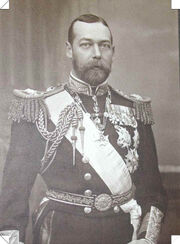| ||||||||||||||||||||||||||||||||||||||||||||
George V (George Frederick Ernest Albert; 3 June 1865 – 20 January 1936) was King of the United Kingdom and the British Dominions, and Emperor of India, from 6 May 1910 until his death in 1936.
Born during the reign of his grandmother Queen Victoria, George was the second son of Albert Edward, Prince of Wales, and was third in the line of succession to the British throne behind his father and elder brother, Prince Albert Victor. From 1877 to 1892, George served in the Royal Navy, until the unexpected death of his elder brother in early 1892 put him directly in line for the throne. On Victoria's death in 1901, George's father ascended the throne as Edward VII and George was created Prince of Wales. He became king-emperor on his father's death in 1910.
George's reign saw the rise of socialism, communism, fascism, Irish republicanism, and the Indian independence movement, all of which radically changed the political landscape of the British Empire. The Parliament Act 1911 established the supremacy of the elected British House of Commons over the unelected House of Lords. As a result of World War I (1914–1918), the empires of his first cousins Nicholas II of Russia and Wilhelm II of Germany fell, while the British Empire expanded to its greatest effective extent. In 1917, he became the first monarch of the House of Windsor, which he renamed from the House of Saxe-Coburg and Gotha as a result of anti-German public sentiment. In 1924, George appointed the first Labour ministry and the 1931 Statute of Westminster recognized the Empire's dominions as separate, independent states within the British Commonwealth of Nations.
He suffered from smoking-related health problems throughout much of his later reign, and at his death was succeeded by his eldest son, Edward VIII.
George V in "Last Flight of the Swan of the East"[]
George V was the King of the British Empire when the Great War broke out. As the alliances were drawn, many wondered which side Great Britain would join. George's family was of German descent, and British relations with Germany had been fairly close, whereas relations with France had been noticeably frosty since the advent of leviathan airships.[1]
George's government simply sat out the war in 1914, and continued its neutrality into 1915.
For further info, see the Leviathans wiki.
George V in Southern Victory[]
George V was the King of Great Britain during the Great War.[2] He was the last British monarch to hold a number of titles previously afforded to the ruler of the British Empire, including King of Ireland and King of Canada, both of which he was forced to relinquish by the victorious Central Powers at the end of the Great War.[3]
Jake Featherston derisively compared Wade Hampton V to the British king during the 1921 Confederate presidential campaign, a somewhat provocative act, considering how staunchly Britain had supported the Confederate States.[4]
Upon his death in January 1936, he was succeeded by his eldest son Edward VIII, who led Britain to defeat at the hands of the Central Powers in the Second Great War (1941-1944).[5]
See Also[]
- References to Historical Figures in Turtledove's Work for more minor references.
- Unnamed King of Albion, an analog of George V in Every Inch a King.
References[]
- ↑ Leviathans: Armored Skies, pgs. 294, loc. 4210, ebook.
- ↑ American Front, pg. 33, pb.
- ↑ See, e.g., Walk in Hell, pgs. 462-465, pb.
- ↑ Blood and Iron, pg. 441, pb.
- ↑ In at the Death, pg. 359, PB.
| Titles and Succession | ||||||||||||||||||||||
|---|---|---|---|---|---|---|---|---|---|---|---|---|---|---|---|---|---|---|---|---|---|---|
| ||||||||||||||||||||||
| |||||||||||||||||||||||
| ||||||||











